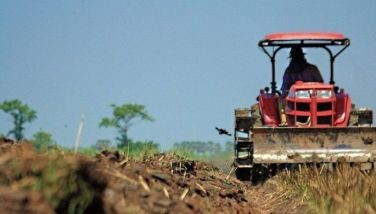Twin carabaos now possible
December 4, 2005 | 12:00am
It is now possible for Philippine carabaos to give birth to twins.
Through a scientific technique called nonsurgical embryo transfer, twinning of water buffaloes can be enhanced, it was found by researchers of the DA-Philippine Carabao Center (PCC) based in Muñoz, Nueva Ecija – Danilda Duran, Prudencio Pedro, Apolinario Salazar Jr., Hernando Venturina, Peregrino Duran, and Libertado Cruz.
Their study formed part of the PCARRD-funded project "Production of high genetics water buffaloes through the use of recent reproductive biotechniques".
The PCC research placed second (research category) in the 2005 Best R&D Paper Award conferred during the PCARRD-organized NSARRD last Nov. 9.
The researchers said that twinning is a rare occurrence in water buffalo unlike in cattle, hence, results of the study are of significant economic importance, especially in the production of genetically superior buffalo.
To enhance twinning, the researchers transferred two to three artificially produced embryos (fertilized eggs) nonsurgically to 26 recipient animals. Twenty of these animals received two embryos and six received three.
The process resulted in 23 percent calving rate, of which 16.6 percent were twins. The result of the study shows for the first time birth of twins in water buffaloes out of artificially produced embryos.
Another study under the DA-PCC project found that native carabaos can be surrogate mothers for artificially produced and preserved Murrah river buffalo embryos from India. It also placed second (Development category) in the PCARRD-sponsored NSARRD.
The researchers said that in countries where swamp-type is the dominant buffalo breed, infusion of imported river-type has been started to improve milk and meat production but with reported incidence of large-calf syndrome, a situation of fatal disregulation where the calves grow bigger than what they should be.
The larger river buffalo, exemplified by the India and subcontinent breeds, falls under the dairy category as it possesses high genetic capacity for such products, unlike the swamp-type Philippine buffalo.
The embryo transfer technique, therefore, promises to optimize reproduction and production performances of improved buffaloes in farming areas. – RAF
Through a scientific technique called nonsurgical embryo transfer, twinning of water buffaloes can be enhanced, it was found by researchers of the DA-Philippine Carabao Center (PCC) based in Muñoz, Nueva Ecija – Danilda Duran, Prudencio Pedro, Apolinario Salazar Jr., Hernando Venturina, Peregrino Duran, and Libertado Cruz.
Their study formed part of the PCARRD-funded project "Production of high genetics water buffaloes through the use of recent reproductive biotechniques".
The PCC research placed second (research category) in the 2005 Best R&D Paper Award conferred during the PCARRD-organized NSARRD last Nov. 9.
The researchers said that twinning is a rare occurrence in water buffalo unlike in cattle, hence, results of the study are of significant economic importance, especially in the production of genetically superior buffalo.
To enhance twinning, the researchers transferred two to three artificially produced embryos (fertilized eggs) nonsurgically to 26 recipient animals. Twenty of these animals received two embryos and six received three.
The process resulted in 23 percent calving rate, of which 16.6 percent were twins. The result of the study shows for the first time birth of twins in water buffaloes out of artificially produced embryos.
Another study under the DA-PCC project found that native carabaos can be surrogate mothers for artificially produced and preserved Murrah river buffalo embryos from India. It also placed second (Development category) in the PCARRD-sponsored NSARRD.
The researchers said that in countries where swamp-type is the dominant buffalo breed, infusion of imported river-type has been started to improve milk and meat production but with reported incidence of large-calf syndrome, a situation of fatal disregulation where the calves grow bigger than what they should be.
The larger river buffalo, exemplified by the India and subcontinent breeds, falls under the dairy category as it possesses high genetic capacity for such products, unlike the swamp-type Philippine buffalo.
The embryo transfer technique, therefore, promises to optimize reproduction and production performances of improved buffaloes in farming areas. – RAF
BrandSpace Articles
<
>
- Latest
Latest
Latest
April 10, 2024 - 5:12pm
By Ian Laqui | April 10, 2024 - 5:12pm
March 4, 2024 - 3:32pm
By Ian Laqui | March 4, 2024 - 3:32pm
March 4, 2024 - 2:12pm
By Kristine Daguno-Bersamina | March 4, 2024 - 2:12pm
February 17, 2024 - 2:31pm
February 17, 2024 - 2:31pm
February 13, 2024 - 7:17pm
By Ian Laqui | February 13, 2024 - 7:17pm
Recommended




























